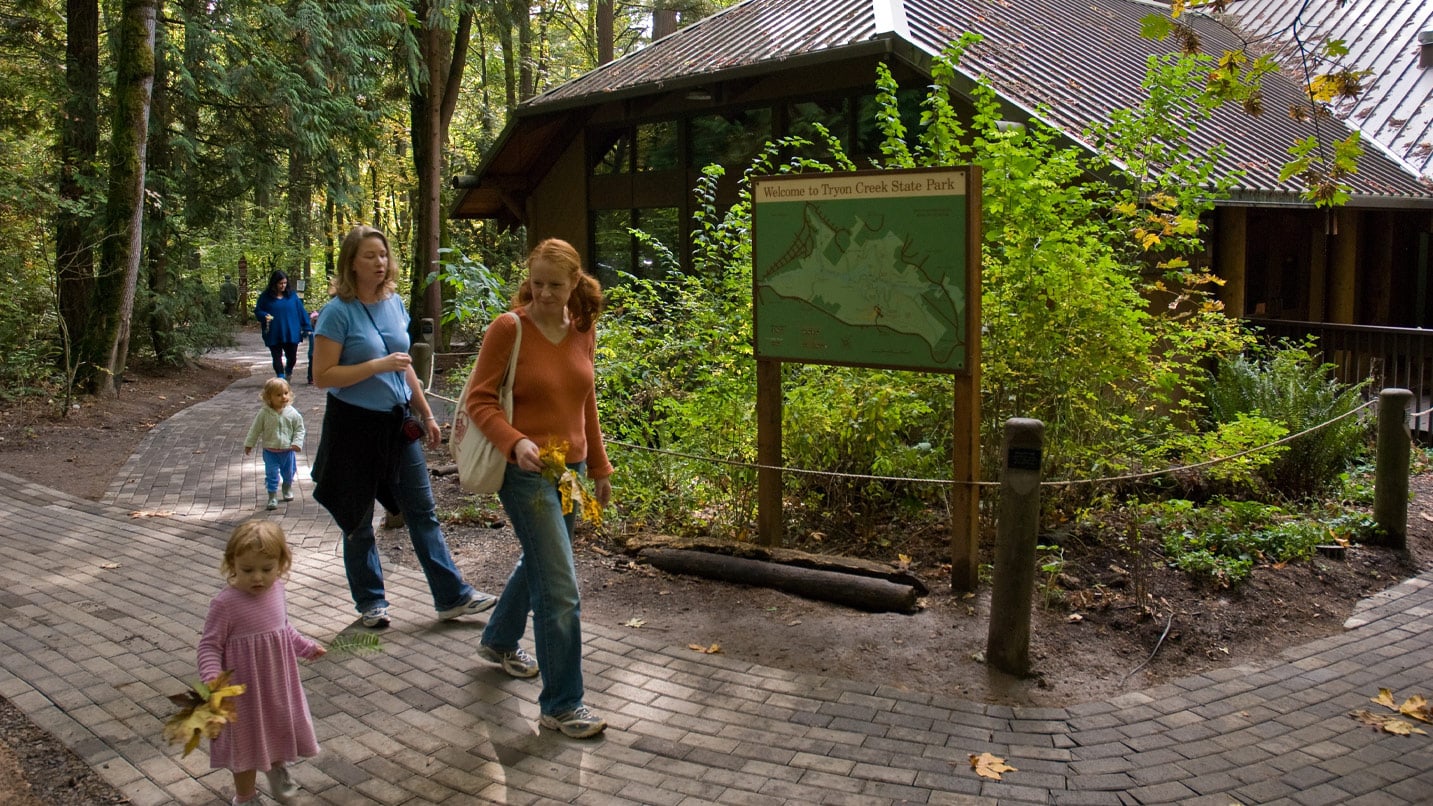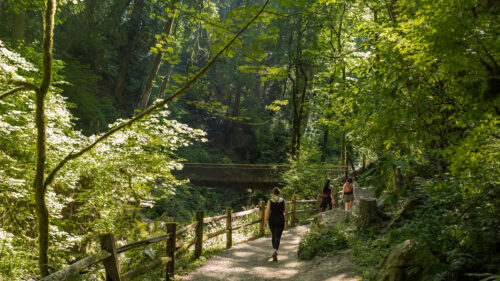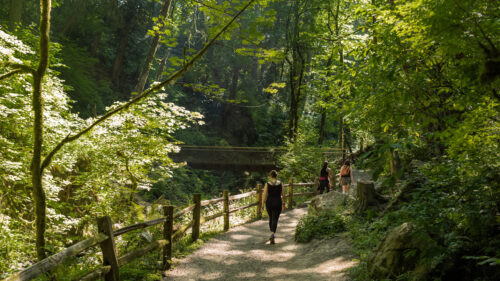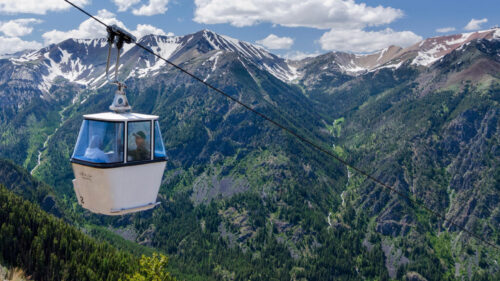Like a hero drawing a sword from its sheath, Ranger Rhett Wilkins of Tryon Creek State Natural Area pulls out a 2-foot-long preserved owl wing from his backpack. Tufts of down and speckled feathers glimmer in the light breaking through the canopy of Douglas fir and Western hemlock. Ten children lean forward in excitement.
A group of us, including parents and kids, had driven to this state park in Southwest Portland for a ranger-led hike. It hosts free themed hikes geared to ages 5 and older on Saturday mornings all year long. Topics are fun for kids, teaching them about woodpeckers or watershed ecology, for example. No reservations are needed. That day our hike was specifically about owls.

Take a Hike Through the Forest
We meet at the Nature Center, which serves as a hub for the park, provides information about park activities and hosts interpretive exhibits. The 658-acre park, which is considered the only state park within the limits of a major city in Oregon, lies in a deep, forested ravine. That doesn’t mean hikes are all about climbing, though. The family-friendly walks like the one we’re taking are short — about a mile — and adapted to kids’ attention spans.
We head down one of the trails that extend from the center at a leisurely pace, stopping frequently. Around us in the forest canopy are distinct leaves of red-leaf maples and Oregon ash, while Oregon grape, red huckleberry and lady fern thrive in the understory. Here and there are stumps of old-growth Western red cedar, left from the era when logging swept through the area.

“There are five species of owl residing in Tryon,” Wilkins says, crouching down by a Western sword fern and pointing to spatters of white on the leaves. “And this poop is probably from a Northern saw-whet owl but could be from a Cooper’s hawk.”
At the mention of poop, the children are elated. Wilkins has their attention. He draws magical items from his backpack like owl skulls, egg replicas and photos. One shows a close-up of a Western screech owl with a mouse clutched in its talons and a nest brimming with baby barred owl fluff balls.
With pursed lips, he demonstrates an owl toot — the technical term for an owl hoot — which they promptly imitate.
“Does anyone know what ‘nocturnal’ means?” the ranger asks after pointing out an owl pellet, full of tiny bones regurgitated after snacking on prey.
Three hands shoot up. “That means only active at night,” a girl responds with a confident nod of her chin. The intrigue of night allows him to explain how owls feed while most of us are asleep.
With such engaging content, the guided hike can be just as pleasurable for parents as it is for the kids. Some interested parents and grandparents chime in with specific questions about owl habitats and identification, and others merely allow the ranger to captivate and educate their children while they relax and stroll under the rain forest canopy.
If you’re inspired to continue after a guided hike, the park has 8 miles of trails. Many of the trails head down to Tryon Creek. You might cross some of the eight bridges and a boardwalk over wetlands, stopping to admire gullies or scanning the marshes for a beaver or salamander, two residents of those areas. The 0.3-mile Trillium Trail accommodates wheelchairs and most adaptive needs on a paved path with benches and viewing platforms.

Getting to and Around the Park
About 7 miles south of downtown Portland, the park is a popular place for Portland’s outdoor enthusiasts, so parking is at a premium, especially on nice weekend days. Consider arriving early, when spots are more plentiful, to make use of the picnic area.
For car-free transportation, there are a number of TriMet bus stops near the park. The S Huddleson & Palatine Hill stop on the 39 line to Lewis and Clark College brings you near the southern part of the park. On the 38 line, the Boones Ferry & Palatine stop drops you right at a trailhead on the park’s eastern border. The N State & E Ave stop on the 35 line in Lake Oswego lands you at the southernmost access point of the park.
Cyclists who ride to the park will enjoy the 3 miles of paved bike paths along the park’s eastern border; bike parking is available at the Nature Center.

Places to Eat and Stay
The southernmost part of Tryon Creek State Natural Area abuts the edge of downtown Lake Oswego, which has a number of tasty restaurant options. If you want a treat after an early-morning forest jaunt, head to Blue Star Donuts, just a half-mile from the trail end. Its flavors include some for the grown-ups, like blueberry basil bourbon. Nearby is Dang’s Thai Kitchen, featuring dishes like spicy cashew stir-fries and rich vegetable curries. After a day on the trail, the Lakeshore Inn is an ideal place to hang your hat. Its pool sits on a deck that juts right into Lakewood Bay, and the rooms have patios with lake views as well.
Other Free Ranger-Led Tours
Owls aren’t the only birds in Tryon’s lush oasis. Birders might notice violet-green swallows, kingfishers, great blue herons and pileated woodpeckers, which mingle with the park’s other wildlife. Rangers lead bird walks on Friday mornings to learn more about avian life in the park. There are also guided hikes at dusk on topics like bats and annual events like Indigenous Culture Day, with activities related to land reclamation that are free and open to all.
On the Oregon Coast south of downtown Astoria, rangers at Lewis and Clark National Historical Park host three-hour kayak tours along the banks of the Lewis and Clark River several times a week from July through early September. Rangers discuss wildlife and cultural highlights, and gear is provided.
Several times each summer, Eastern Oregon’s Cottonwood Canyon State Park on the John Day River has evening programming on dark-sky preservation. Arrive a little early for sun viewing with specialized solar telescopes. When evening falls, rangers give a 45-minute lecture on dark skies, and Rose City Astronomers volunteer to help participants view the stars. Pre-registration is required.



